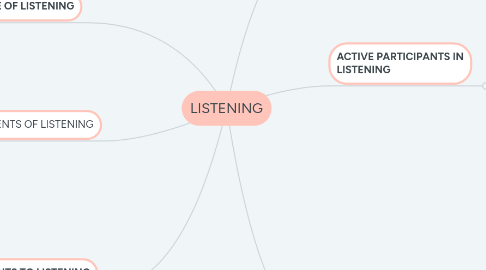LISTENING
저자: Kobong Makhetha


1. IMPORTANCE OF LISTENING
1.1. 50% of communication depends on our ability to listen
1.2. We spend 42 to 57 per cent of our communication time listening
1.3. Listening helps us to understand
1.4. We listen to identify and interpret messages
2. COMPONENTS OF LISTENING
2.1. Focusing
2.2. Comprehending
2.3. Responding
2.3.1. Active listening is another form of responding and helps a listener to understand
3. IMPEDIMENTS TO LISTENING
3.1. External distractions in the surrounding
3.2. Listener's physical impairment
3.3. Listener's interest
3.4. Speaker's mannerisms, dress or appearance
3.5. Nature of language used
3.6. Listener's eagerness to reply to the speaker
3.7. Listener's defensiveness
4. TYPES OF LISTENING
4.1. Appreciative
4.2. Informative
4.3. Evaluative
4.4. Empathetic
5. ACTIVE PARTICIPANTS IN LISTENING
5.1. Student as a listener
5.1.1. Listening is used the most ( 42%) but students receive very little instruction (8%)
5.2. Teacher as a listener
5.2.1. Shows the students that you value them
5.2.2. Help students deal with their emotions
5.2.3. Helps students to not be afraid of their strong feelings
5.2.4. Solve personal and academic problems
5.2.5. Fosters trust and respect
5.2.6. Increases students' inclination to listen
6. GOOD LISTENING HABITS
6.1. Hear the speaker out before you judge him or her
6.2. Listen for main ideas, principles and concepts
6.3. Listen a few minutes before taking notes
6.4. Counteract the distractions
6.5. Learn to listen to difficult material
6.6. Listen for the message behind the emotions.
6.7. Use your ability to think faster than you can listen
6.7.1. Thinking ahead to the next point
6.7.2. Making contrasts and comparisons
6.7.3. Identifying the speaker's evidence
6.7.4. Summing up the speaker's points in your mind
